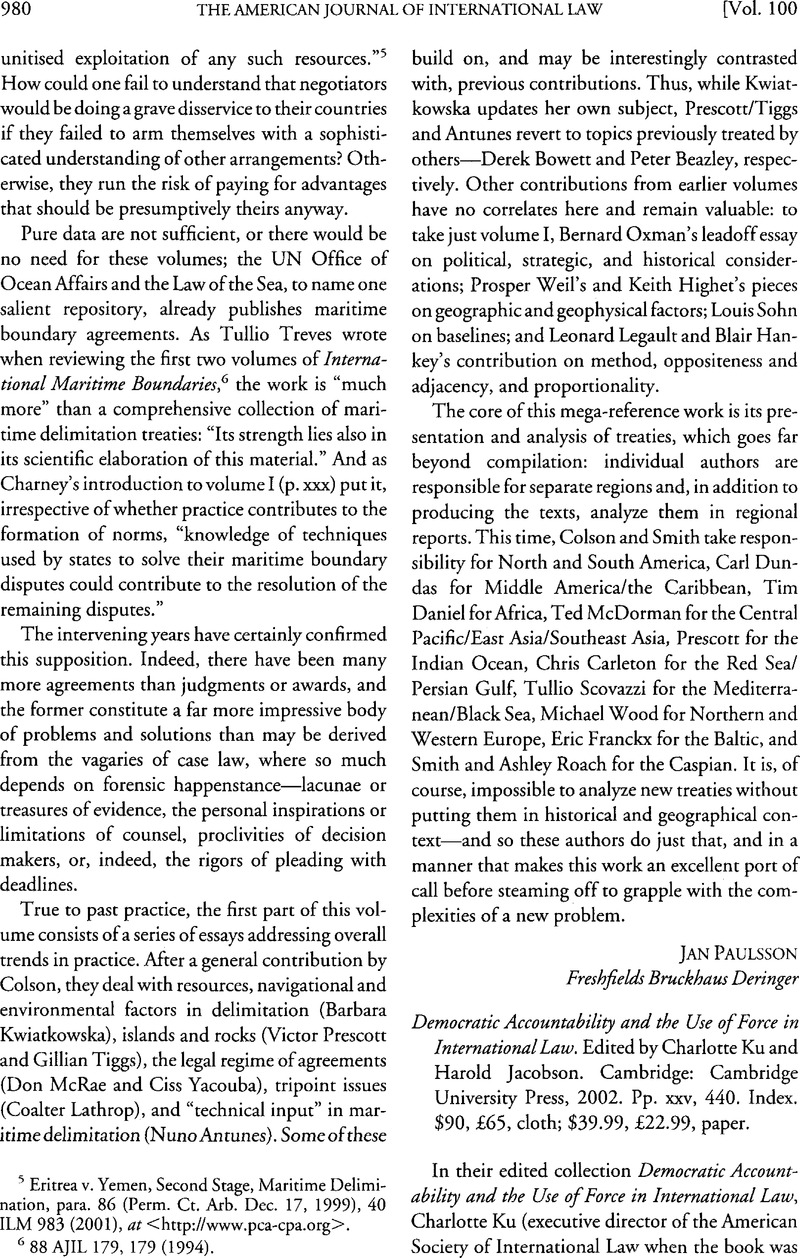Published online by Cambridge University Press: 27 February 2017

1 Considering the unilateralism with which the United States has prosecuted the war in, and occupation of, Iraq, one cannot help but look back with some sadness (and sense of loss) when reading today Ku and Jacobson’s declaration that, when invading Afghanistan in 2001 after the September 11 terrorist attacks, the “US government paid close attention to the reactions, not only of its own citizens, but of a diverse global public opinion” (p. 3).
2 “One of the difficulties one must face at the outset is that there is no democratic theory—there are only democratic theories.” Robert, A. Dahl, A Preface to Democratic Theory 1 (1956).Google Scholar
3 Martin, Nettesheim, Developing a Theory of Democracy for the European Union, 23 Berkeley J. Int’l L. 358, 359 (2005).Google Scholar
4 It is true, as Ku and Jacobson point out (p. 11), that Held views the existing international infrastructure as inadequate to the task of promoting and sustaining democracy as an international matter. But he sees the way out. See David, Held, Democracy and the Global Order 265–86 (1995)Google Scholar; David, Held, Models of Democracy 335–60 (2d ed. 1996)Google Scholar; David, Held, Cosmopolitanism: Ideas, Realities and Deficits, in Governing Globalization 305, 317–20 (David, Held & Anthony, McGrew eds., 2002).Google Scholar
5 Jürgen Habermas, in particular, has forged a new democratic theory in response to the growing significance of the supranational European Union. His theory of discursive democracy imagines a European public sphere that transcends the traditional base of democratic governance—namely, the nation state. See Jürgen, Habermas, Between Facts and Norms: Contributions to a Discourse Theory of Law and Democracy (William, Rehg trans., 1996)Google Scholar; Jürgen, Habermas, The Postnational Constellation: Political Essays (Max. Pensky ed., 2001)Google Scholar; Jürgen, Habermas, Why Europe Needs a Constitution, New Left Rev., Sept./Oct. 2001, at 5, 14, 17.Google Scholar Habermas is optimistic that such features can be achieved at the supranational level in Europe.
6 Francis, Fukuyama, The End of History and the Last Man (1992).Google Scholar
7 ‘“Low intensity democracy’ is one of a number of phrases that have been coined to highlight the relative formality of this conception of democracy. Others include ‘cosmetic democracy’ and ‘facade democracy’, as well as expressions which eschew reference to democracy altogether.” Susan, Marks, The Riddle of all Constitutions 53–54 (2000)Google Scholar (citing Barry, Gills, Joel, Rocamora, & Richard, Wilson, Low Intensity Democracy, in Low Intensity Democracy: Political Power in the new World Order 3 (Barry, Gills, Joel, Rocamora, & Richard, Wilson eds., 1993)Google Scholar, and William, I. Robinson, Promoting Polyarchy: Globalization, US Intervention, and Hegemony (1996)Google Scholar).
8 “A conception of democracy tends to prevail... in which certain institutions—above all, the holding of periodic multiparty elections and the official separation of public powers—are taken largely to suffice. A signally undemanding standard is set with regard to more farreaching objectives, such as enhancing respect for human rights, social justice, and civilian control of the military’’ Id. at 53 (emphasis added).
9 Id. at 54–59.
10 See generally Held, Models of Democracy, supra note 4; Arend, Lijphart, Patterns of Democracy (1999)Google Scholar; Robert, A. Dahl, Democracy in the United States: Promise and Performance (1996)Google Scholar; see, e.g., habermas, between facts and norms, supra note 4; habermas, the postnational constellation, supra note 5; Deirdre, M. Curtin, Postnational Democracy: The European Union in Search of a Political Philosophy (1997)Google Scholar; John, S. Dryzek, Discursive Democracy (1990)Google Scholar; John, S. Dryzek, Deliberative Democracy and Beyond (2004)Google Scholar; Deliberative Democracy (Jon, Elster ed., 1998)Google Scholar; Deliberative Democracy: Essays on Reason and Politics (James, Bohman & William, Rehg eds., 1997)Google Scholar; L. Ali, Kahn, A Theory of Universal Democracy: beyond the End of History (2003)Google Scholar; Will, Kymlicka, Multicultural Citizenship (1996).Google Scholar
11 Alex, Callinicos, The Revenge of History: Marxism and the East European Revolutions (1991)Google Scholar; Alex, Callinicos, Liberalism, Marxism, and Democracy: A Response to David Held, 22 Theory & Soc’y 283 (1993).Google Scholar
12 Russell, A. Miller, Self-Determination in International Law and the Demise of Democracy? 41 Colum. J. Transnat’l L. 601 (2003).Google Scholar
13 Quoting Lori Fisler, Damrosch, Is There a General Trendin Constitutional Democracies Toward Parliamentary Control over War-and-Peace Decisions, 1996 ASIL Proc. 36–40.Google Scholar